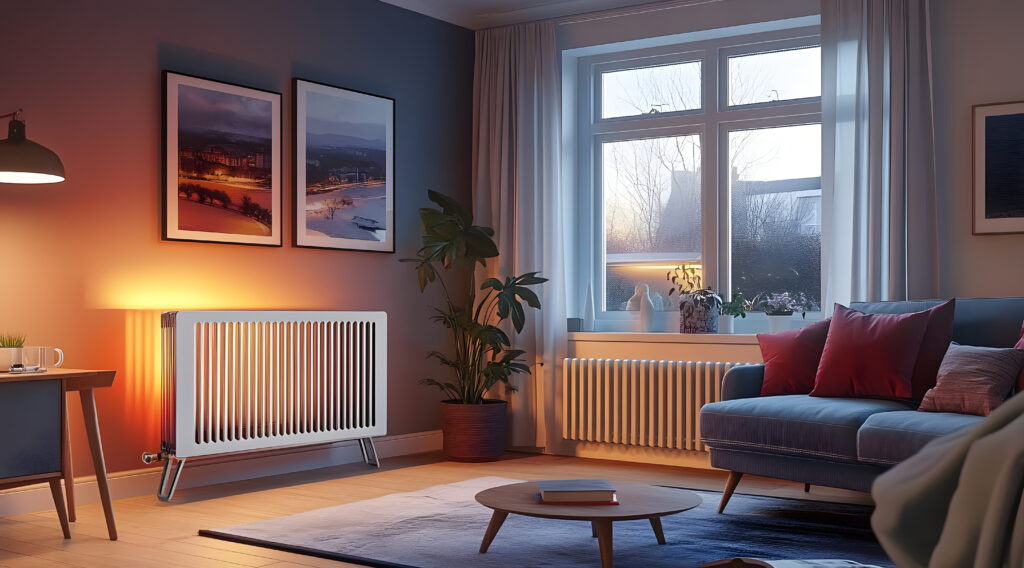As the temperatures drops, it’s important to ensure your home remains warm and comfortable. For tenants in Tunbridge Wells, keeping a rental property at the right temperature can sometimes be challenging, particularly when energy prices are high. However, with a few practical steps, you can make your living space warmer while keeping costs manageable. Below, we’ve compiled our top tips to help you keep the chill at bay this winter.

1. Maximise Your Heating Efficiency
One of the simplest ways to keep your home warm is by ensuring your heating system is working efficiently. Check your radiators to see if they need bleeding. If your radiator is cold at the top but warm at the bottom, it’s a sign that air is trapped inside and needs releasing.
How to Bleed a Radiator:
- Turn off your heating to avoid water spraying out.
- Hold an old cloth or container to catch any escaping water, use a radiator key to slowly turn the valve at the top of the radiator.
- You should hear a hissing sound as the trapped air escapes.
- Once water begins to trickle out, close the valve tightly.
- Turn your heating back on and check the radiator’s temperature.
Bleeding your radiators will help them heat your home more effectively, saving both energy and money.
2. Keep Internal Doors Closed
Keeping doors closed within your home helps to retain heat in the rooms you are using. Open doors allow warm air to escape and cold air to enter, making your heating system work harder to maintain a consistent temperature. By closing internal doors, you can create warmer pockets of air and reduce overall heat loss.
3. Use Curtains and Blinds Wisely
Your windows are one of the biggest culprits when it comes to heat loss. To reduce this, make sure to draw your curtains or blinds as soon as the sun goes down. Heavy, lined curtains are particularly effective at trapping heat inside your home.
During the day, keep curtains open to allow natural sunlight to warm your space. Even in the winter, the sun’s rays can provide a surprising amount of warmth.
4. Stop Draughts with Excluders
Draughts can quickly make a warm room feel chilly, so it’s important to identify and block any gaps where cold air might be getting in. Common areas for draughts include:
- Around doors and windows
- Keyholes
- Letterboxes
Invest in draught excluders to block gaps under doors. For windows, consider using self-adhesive draught strips or sealing gaps with silicone sealant. These small changes can make a big difference in keeping your home warm.
5. Dress in Layers
It’s not just your home that needs to be warm—you do too! Wearing layers is a more effective way to stay warm than wearing one thick item of clothing. Layers trap heat between each garment, providing better insulation.
Start with a base layer, such as a thermal top or leggings, followed by a middle layer for insulation (e.g., a jumper or fleece), and finish with a breathable outer layer if needed. Don’t forget cosy socks, slippers, and a blanket for when you’re sitting down.
6. Be Mindful of Ventilation
While keeping your home warm is a priority, it’s important not to neglect ventilation. Poor ventilation can lead to condensation, which in turn can cause mould and damp issues. To prevent this:
- Open windows briefly each day to allow fresh air to circulate.
- Use extractor fans in the kitchen and bathroom.
- Wipe away any condensation that forms on windows or walls.
- Consider using a dehumidifier.
By balancing warmth with proper ventilation, you can maintain a healthy living environment.
7. Use Heating Timers and Thermostats
Most heating systems come with programmable timers and thermostats that allow you to control when your heating comes on and off. Set your heating to come on just before you wake up and switch off when you leave for work to save energy.
Aim to maintain a consistent temperature, ideally between 18-21°C, to keep your home comfortable without overworking your heating system.
8. Make Use of Rugs and Soft Furnishings
If you have hard flooring, adding rugs can help to reduce heat loss and keep your home warmer. Rugs act as an insulating layer, especially if placed on top of cold surfaces like tiles or laminate flooring.
Similarly, soft furnishings such as cushions and throws can add a cosy feel to your home while also helping to retain warmth.
9. Consider Temporary Insulation Solutions
If your property is particularly draughty or has older windows, there are some temporary insulation solutions you can try:
- Use window film to create an additional barrier to heat loss.
- Place reflective panels behind radiators to direct heat back into the room.
- Use door draft excluders to block gaps under external doors.
These inexpensive solutions can help reduce heat loss and improve the overall warmth of your home.
Stay Cosy with Belvoir Tunbridge Wells
We hope these tips help you keep your home warm and cosy this winter. At Belvoir Tunbridge Wells, we care about your comfort and wellbeing as a tenant. If you have any concerns about your property’s heating or insulation, don’t hesitate to contact our team for advice. We’re here to help you make the most of your home, no matter the season.
Stay warm and take care!










